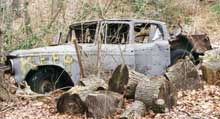And a tail tuck. Studebaker introduced the 1959 Lark, its first “compact” model, as THE NEW DIMENSION IN MOTORING. Inspired by American Motors’ success in reviving the 1955 Rambler as the Rambler American, Studebaker sought to crib a maneuver from AMC’s playbook. But Studebaker had to do more than dust off old dies, since all previous Studies were considerably more than “compact.” Anticipating the 1962 hit song “She Got a Nose Job” (recorded by Jeanne Hayes, Mike Russo and the Dellwoods for Big Top Records), Studebaker took the old sedan tub, developed for 1953, and gave it a nose- and tail job, then added the panoramic windshield greenhouse first seen in 1955.
It was pretty effective. Although the wheelbase shrank by just eight inches, overall length of sedans and wagons was lopped by a whopping 25 inches. To my eyes, the amputation improved the proportions of the car markedly. Particularly attractive was the hardtop coupe, as was the convertible, Studie’s first since 1952, introduced the next year. Metal stamping economies were apparent inside, too: the Lark’s instrument panel used the tooling developed for 1956. For 1962 and ’63 the Lark gained a Mercedes-inspired grille, perhaps influenced by Studebaker’s US distribution arrangement for the German automaker. For ’64 there was another nose job, and another new tail treatment and roof line.
By 1965, every American automaker needed a vinyl roof and bucket seats, and Studebaker wouldn’t be left behind. By that time, though, production had long since moved to Canada. Studebaker’s engine foundry had remained in Indiana, so Chevrolet powerplants were purchased. Oddly, the 1965 brochure used an outdated illustration for Studebaker’s own V8 (calling it “brand new Thunderbolt V8 engine (283 cu. in. displacement…) instead of the small block Chevy actually in the car.
It wasn’t enough. Although Studebaker’s sales, which had languished around 13th place in the mid 1950s, surged to tenth for 1959, the introduction of compact cars, the Ford Falcon, Chevrolet Corvair and Chrysler Corporation’s Valiant, by the Big Three for 1960, sent Stude’s sales skidding again. The last Studebaker, a 1966 Cruiser four-door sedan, was built on March 16, 1966. It had been a long road, in the end a dead-end street, but Studebaker had certainly got its money out of those 1953 body dies.

